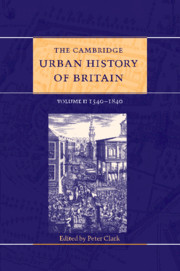Book contents
- Frontmatter
- 1 Introduction
- Part I Area surveys 1540–1840
- Introduction
- 2(a) England: East Anglia
- 2(b) England: South-East
- 2(c) England: South-West
- 2(d) England: Midlands
- 2(e) England: North
- 3 Wales
- 4 Scotland
- Part II Urban themes and types 1540–1700
- Part III Urban themes and types 1700–1840
- Select Bibliography
- Index
- References
4 - Scotland
from Part I - Area surveys 1540–1840
Published online by Cambridge University Press: 28 March 2008
- Frontmatter
- 1 Introduction
- Part I Area surveys 1540–1840
- Introduction
- 2(a) England: East Anglia
- 2(b) England: South-East
- 2(c) England: South-West
- 2(d) England: Midlands
- 2(e) England: North
- 3 Wales
- 4 Scotland
- Part II Urban themes and types 1540–1700
- Part III Urban themes and types 1700–1840
- Select Bibliography
- Index
- References
Summary
THE SIXTEENTH-CENTURY PATTERN
in the early sixteenth century Scotland was undoubtedly less urbanised than England. Data on the population size of Scottish towns are very rare before the middle decades of the seventeenth century but Jan de Vries has calculated that in 1550 1.4 per cent of the Scottish population lived in towns of 10,000 inhabitants or more compared to 3.5 per cent in England and Wales. Another estimate, by Ian Whyte, suggests that 2.5 per cent of Scots were dwelling in towns of over 2,000 in population in 1550 whereas in 1600 8.7 per cent of the population of England were living in towns of this size or bigger. Not only was Scotland an overwhelmingly rural society in this period, more akin to countries such as Ireland and Denmark than to England or Holland, it was also one where urban development was very regionally concentrated. Whole areas, especially in the Highlands and southern Uplands, lacked any urban focus and were distant from any developed marketing centre. In the main, the Scottish towns of the sixteenth century were located in the central Lowlands, especially around the estuaries of the Forth, Tay and Clyde, along the east coast from Edinburgh to Aberdeen and in the lower Tweed valley to the south. These were regions of relatively dense population and rich arable land. It is also the case that in some of these areas town development was extensive and contrasted with the national pattern of very modest urban growth. Recent demographic research on the seventeenth-century hearth taxes has shown that the five counties around the River Forth, East Lothian, Midlothian, Fife, Clackmannan and West Lothian, had by far the highest percentage of town dwellers in Scotland with a level of urbanisation which could be compared to parts of the Netherlands.
- Type
- Chapter
- Information
- The Cambridge Urban History of Britain , pp. 151 - 164Publisher: Cambridge University PressPrint publication year: 2000
References
- 7
- Cited by



